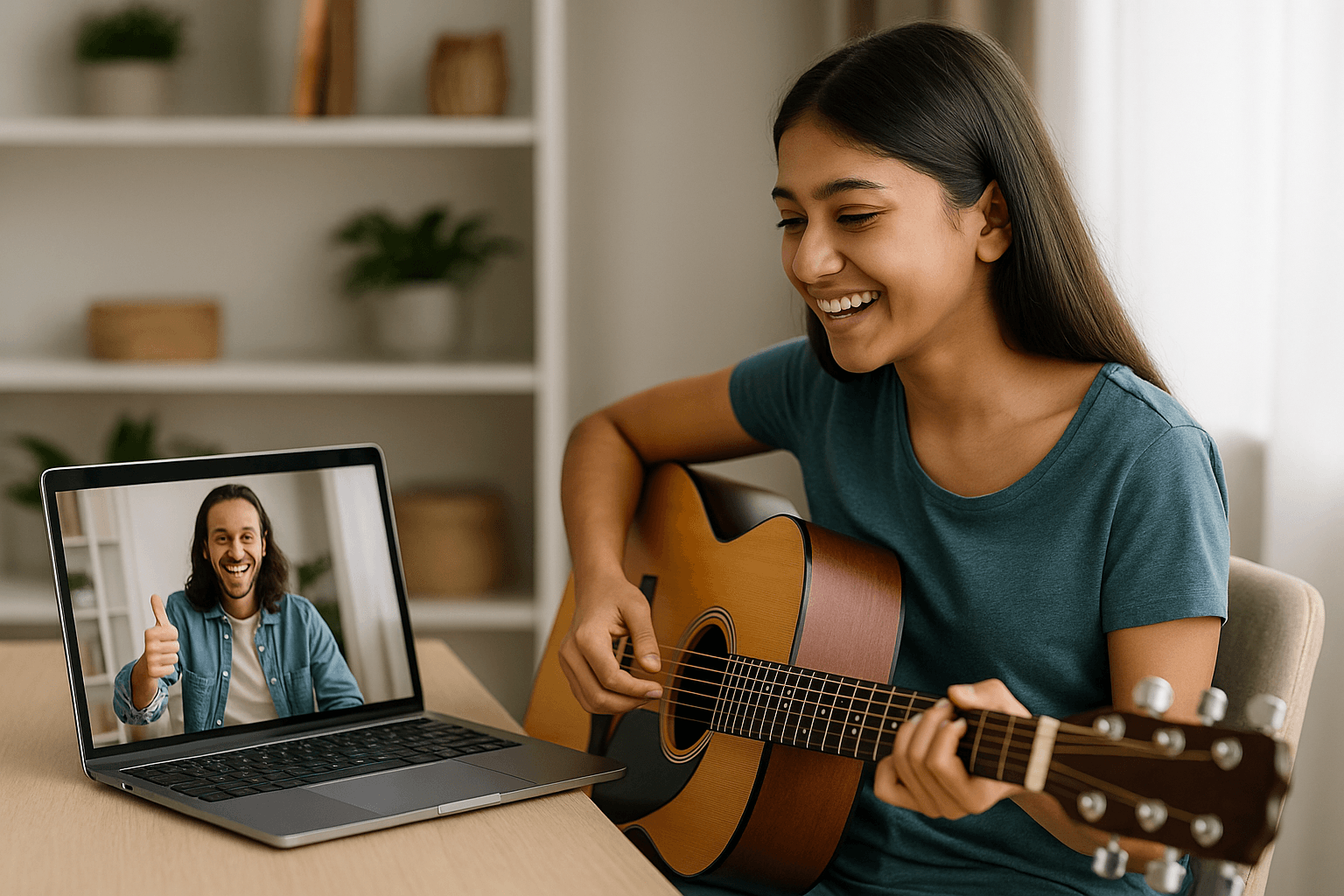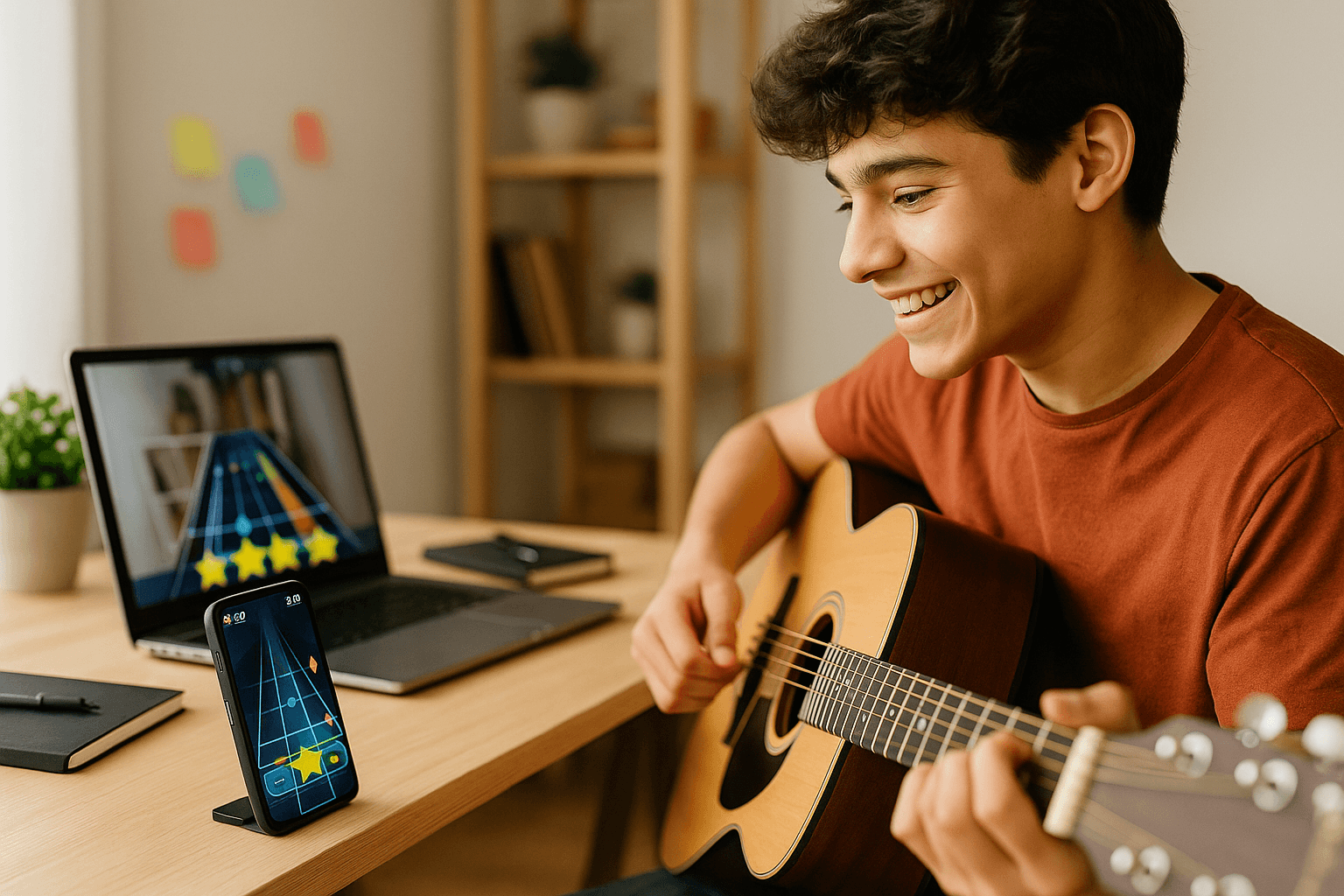
Art Gharana — 6 Mins read
Emotional Piano Songs to Play Today
Musical Instruments
Learning guitar is one of those journeys that feels both exciting and challenging at the same time. Many beginners start with enthusiasm, only to lose interest when practice feels repetitive. But what if your guitar lessons could be as enjoyable as listening to your favorite fun guitar songs? The key is to make learning interactive, creative, and inspiring rather than a routine filled only with scales and drills.
Think about it: wouldn’t it be more motivating to practice when you’re playing easy guitar chords songs or jamming along to popular songs with easy chords you already love? Whether you’re just starting with easy guitar for beginners or picking up new cool songs to play on guitar, turning practice into play can transform your progress.
In this blog, we’ll explore practical ways to make your guitar sessions more enjoyable while still building strong skills. From using games and challenges, to exploring beginner pop songs on guitar, to even experimenting with the fun side of electric guitar — you’ll discover strategies to keep your learning both effective and exciting. So grab your guitar, and let’s find out how to make every lesson something you genuinely look forward to.
 One of the quickest ways to lose interest in guitar practice is to repeat the same dull drills every day. But here’s the secret: when you add music you love into the process, practice no longer feels like work — it feels like play. Imagine sitting down to practice and strumming along to fun guitar songs or testing your skills with easy guitar chords songs you already recognize. Suddenly, progress feels natural and enjoyable.
One of the quickest ways to lose interest in guitar practice is to repeat the same dull drills every day. But here’s the secret: when you add music you love into the process, practice no longer feels like work — it feels like play. Imagine sitting down to practice and strumming along to fun guitar songs or testing your skills with easy guitar chords songs you already recognize. Suddenly, progress feels natural and enjoyable.
So, how do you make your lessons song-driven without losing focus on learning? Here are some ideas:
Think of this as building a “fun-first” practice habit. Each time you learn a new tune, you’re not just adding to your repertoire — you’re also reinforcing technique, rhythm, and confidence without even realizing it. The more you enjoy what you play, the faster you’ll progress.
So, the next time you pick up your guitar, ask yourself: What song would make practice feel like a jam session today? That simple shift in mindset could be the key to making your learning experience truly rewarding.
 Let’s be honest — repeating scales or chord transitions can feel a little dry. But what if you could turn these exercises into fun challenges that keep you engaged and motivated? With the right approach, even the most basic drills can feel like exciting milestones on your journey to becoming a better guitarist.
Let’s be honest — repeating scales or chord transitions can feel a little dry. But what if you could turn these exercises into fun challenges that keep you engaged and motivated? With the right approach, even the most basic drills can feel like exciting milestones on your journey to becoming a better guitarist.
Here are some creative ways to gamify your guitar practice:
1 Speed Challenges
2 Memory Games
3 Reward-Based Learning
4 Tech-Friendly Tools
When you gamify your lessons, you’re not just practicing — you’re playing, competing, and celebrating progress all at once. This shift in mindset makes it far easier to stay consistent because every practice feels like a challenge you want to win.
And if you’d like structured guidance with engaging techniques like these, consider exploring Art Gharana’s online guitar classes. These sessions are designed to keep your learning lively and interactive, so practice never feels like a chore.
 One of the best ways to stay motivated while learning guitar is to play music you already know and enjoy. Think about it — when you strum along to beginner pop songs on guitar, practice instantly feels less like an exercise and more like a jam session. The familiarity of the tune keeps you engaged, while the simplicity of the chords helps you build confidence.
One of the best ways to stay motivated while learning guitar is to play music you already know and enjoy. Think about it — when you strum along to beginner pop songs on guitar, practice instantly feels less like an exercise and more like a jam session. The familiarity of the tune keeps you engaged, while the simplicity of the chords helps you build confidence.
Here’s how you can make the most of popular and beginner-friendly tracks in your learning journey:
Start Simple Choose easy guitar for beginners songs that use just a handful of chords. This helps you focus on technique without getting overwhelmed. Even two or three chords can make a full song sound amazing when played with rhythm.
Play Along with Recordings Once you’ve learned the chord progression, practice alongside the original track. It’s a fun way to improve timing, and it makes you feel like you’re playing in a band.
Level Up Gradually After mastering the basics, explore popular songs to play on guitar that add slightly more complex transitions. This gradual progression ensures you’re always challenged without feeling frustrated.
Experiment with Pop Favorites Incorporating easy pop songs to play on guitar can make your sessions more dynamic. Since these songs are usually catchy and well-known, they’re great for performing in front of friends and family too.
What’s powerful about this approach is that every song becomes a building block. You’re not only adding to your playlist but also sharpening essential skills like strumming patterns, chord switching, and rhythm control.
And if you’re unsure which songs to start with, you can always try a free trial class at Art Gharana. Experienced instructors will guide you through beginner-friendly tracks tailored to your taste, making your first steps on guitar both fun and effective.
 For many beginners, picking up an electric guitar feels like stepping into a whole new world. The sound is powerful, versatile, and instantly exciting. But here’s the good news — you don’t need to be a pro to enjoy it. With the right approach, you can dive into easy songs on electric guitar that make practice both fun and rewarding.
For many beginners, picking up an electric guitar feels like stepping into a whole new world. The sound is powerful, versatile, and instantly exciting. But here’s the good news — you don’t need to be a pro to enjoy it. With the right approach, you can dive into easy songs on electric guitar that make practice both fun and rewarding.
Here are a few ways to keep your electric guitar journey exciting:
1 Start with Beginner-Friendly Tunes
2 Experiment with Tone
3 Gradually Increase Complexity
4 Jam for Fun
What makes the electric guitar so enjoyable is its ability to sound “cool” even with minimal effort. Unlike acoustic sessions that often start slow, electric playing lets you feel like a rockstar from day one. That sense of excitement can keep you motivated and consistent in your practice.
And if you’d love structured guidance with beginner-friendly tracks and techniques, Art Gharana’s online guitar classes are the perfect place to start. With expert instructors and step-by-step lessons, you’ll find learning the electric guitar both fun and accessible.
 Your practice space has more impact on your guitar journey than you might realize. A cluttered, uninspiring environment can make practice feel like a chore, while the right setup can transform every session into something you look forward to. So, how do you create an engaging environment that keeps you motivated?
Your practice space has more impact on your guitar journey than you might realize. A cluttered, uninspiring environment can make practice feel like a chore, while the right setup can transform every session into something you look forward to. So, how do you create an engaging environment that keeps you motivated?
Here are a few ideas worth trying:
Mix Songs with Skills Don’t just practice scales in isolation. Blend them with good songs to play on the guitar so that technical drills feel more musical. For example, work on chord changes by playing through songs instead of repeating dry patterns.
Play with Others Music is meant to be shared. Invite a friend or family member to join you for duets or jam sessions. Playing together with nice songs on guitar can bring joy to the process and help you stay accountable.
Encourage Creativity Take a break from covers and create something of your own. Even if it’s just a short riff using song music for guitar, the act of composing boosts your creativity and deepens your connection with the instrument.
Use Backing Tracks Practicing with backing tracks can make you feel like part of a band. It sharpens your rhythm, improves improvisation, and keeps sessions lively.
What’s most important is that your environment should encourage exploration and enjoyment rather than pressure. The more fun you have during practice, the more naturally your skills will grow.
If you’re unsure how to build a structured, engaging practice routine, you don’t have to figure it out alone. At Art Gharana, you can book a trial class and experience firsthand how interactive lessons and guided support make learning guitar both inspiring and effective.
 One of the biggest challenges in learning guitar isn’t technique — it’s staying motivated over time. When every practice session feels the same, it’s easy to lose interest. The secret? Add variety to your routine so that every time you pick up the guitar, it feels fresh, exciting, and rewarding.
One of the biggest challenges in learning guitar isn’t technique — it’s staying motivated over time. When every practice session feels the same, it’s easy to lose interest. The secret? Add variety to your routine so that every time you pick up the guitar, it feels fresh, exciting, and rewarding.
Here are a few strategies to keep things interesting:
1 Build an Inspiring Playlist
2 Alternate Between Acoustic and Electric
3 Record Your Progress
4 Set Short-Term Milestones
What makes variety so powerful is that it prevents burnout. Instead of feeling stuck in repetitive drills, you’re constantly challenged in new and exciting ways. This balance between fun and progress ensures you’ll look forward to every practice session.
And if you’d like expert guidance on staying motivated, Art Gharana’s online guitar classes are designed to keep your learning fresh, engaging, and goal-oriented — so your passion for guitar only grows stronger with time.
Learning guitar doesn’t have to be a rigid process filled only with drills and repetition. When you bring in creativity, variety, and songs you genuinely enjoy, practice becomes something you look forward to rather than something you push yourself to do. Whether it’s strumming along to good guitar songs chords, trying out easy pop songs to play on guitar, or even experimenting with a few cool songs to play on guitar, every session can feel like progress wrapped in fun.
The key is balance — blending technique with music that excites you. By choosing tracks that match your skill level and gradually building up, you’ll stay motivated, consistent, and confident on your journey. After all, isn’t that what music is meant to be — expressive, joyful, and personal?
So the next time you pick up your guitar, ask yourself: What song can I play today that will make this practice feel like a performance? That mindset alone can transform your growth.
And remember, you don’t have to take this journey alone. With the right guidance, your learning can be structured yet enjoyable. If you’re ready to take the next step, why not explore a trial class at Art Gharana? It’s the perfect way to discover how fun and fulfilling your guitar lessons can truly be.